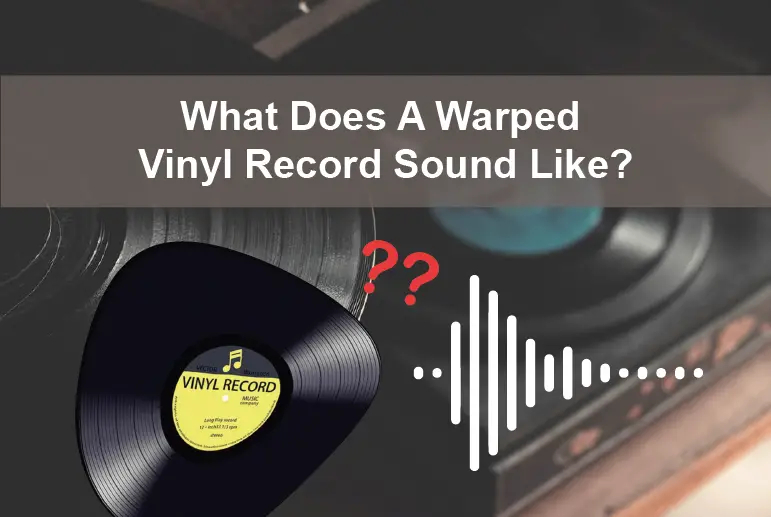We’ve written a few articles about why so many new vinyl records come warped, why new records sound bad, and how to fix the fuzziness of record players. But what exactly does a warped record sound like? If you’re part of the lucky bunch with little experience with warped records, let this post serve as the official induction for you.
As it is with most things, how warped a record is determines how jarring of a sound your record player produces. While many minor record warps go unreported, warps can be a significant issue. This is dependent on the severity of the warp, as well as the height and steepness of the warp, as well as the genre of music. Mistracking, changes in tracking force, vertical tracking angle, and pitch and harmonic fluctuations can all be caused by warps.
To begin, listen to how a severely warped record sounds as it spins beneath the needle:
The periodic clacking and crackles of a disc may be withstandable in the short run, but compromising on sound experience on a player built to amplify every note of a tune is not sustainable, or enjoyable. Variations in the wow and flutter are typically telltale signs. The distortion of the audio will be evident if the record is sufficiently warped.
Now, of course, the video above shows the worst of a warped record. The condition of your disc and the state of your turntable can magnify or dampen the damage, too. Just listen to the sounds of this even more intensely warped record as it plays:
Odd, huh? Compared to the previous example, we can observe how the tracking remains decent despite the condition of the disc. This could be the result of a great tracking force.
Tracking force is a basic concept that can seem intimidating for newcomers or those purchasing their first deck with a tracking force option.
The weight of your record player’s stylus (or needle) on the record is called tracking force. To generate the finest sound and avoid damage to the record, the stylus must make contact with it at the proper weight.
On most entry-level audiophile turntables, you should be able to change the tracking force. However, the option to adjust tracking force on a turntable that costs significantly less might be absent. If your tracking force is too high, the stylus is pressing down on the record too hard. You’ll likely hear greater distortion, which can harm the record in some circumstances.
If the stylus on the record is too light, the force from the grooves may cause the cartridge to rise and the needle to ‘skate’ across the record. This will cause the song to skip, perhaps scratching the record. This is why, in order to get the greatest sound quality and safeguard your vinyl, we must optimize the force. This article succinctly explains how you can go about adjusting the tracking force of your record player.
Likewise, if you need a more extensive guide, check out this great video for a very detailed turntable set up if you’re a beginner or need a refresher course:
While many minor record warps go unreported, warps can be a significant issue. This is dependent on the severity of the warp, as well as the height and steepness of the warp, as well as the genre of music. Mistracking, changes in tracking force, vertical tracking angle, and pitch and harmonic fluctuations can all be caused by warps.
Now that you know what a warped record typically sounds like, knowing how to tell through sight if a disc is bent or curved is simple. There are a few simple ways to detect whether a vinyl record is warped, such as holding it flat at eye level to check if any warping is visible. Piercing a pencil through the center spindle of the vinyl and spinning it lightly is also an option.
Under the presence of light, a warped record will produce a shadow that is not a perfect circle, appearing lopsided or uneven. Here’s a video detailing all these points perfectly:
It will be noted here that your turntable stylus will not be damaged by a slightly warped vinyl. The majority of recordings, particularly older ones, will contain some degree of warp whether it is due to storage or environmental conditions. Fortunately, having a clamp, weight or stabilizer will undoubtedly help to reduce the warp.
Weights, clamps, and, on rare occasions, peripheral rings are among the many accessories available to aid in the stabilization of records. While some believe that these accessories ‘lift’ the sound by tightening frequencies across the spectrum and suppressing any resonance that may occur as the needle tracks the groove of an unsecured record, others believe that they put undue strain on belts and bearings, resulting in too fine a result to appreciate.
Here is a buyer’s guide video comparing between a weight, clamp, and stabilizer if you’re interested in getting one for your turntable:
In general, many vinyl records, especially new ones, will come with a degree of being warp however insignificant. Finding a perfectly flat record is rare, but not entirely impossible. As long as the music is being played fine as it enters your ears, having a mildly warped record should not be a pressing problem.
If you’d like to fix a more severely warped record, there are ways to go about that. Check out our post here on how you can fix vinyl warping, but only attempt so at your own risk.
Here’s a video on what to expect if you’re planning to flatten a disc in your own backyard (spoiler: it involves an oven!):

